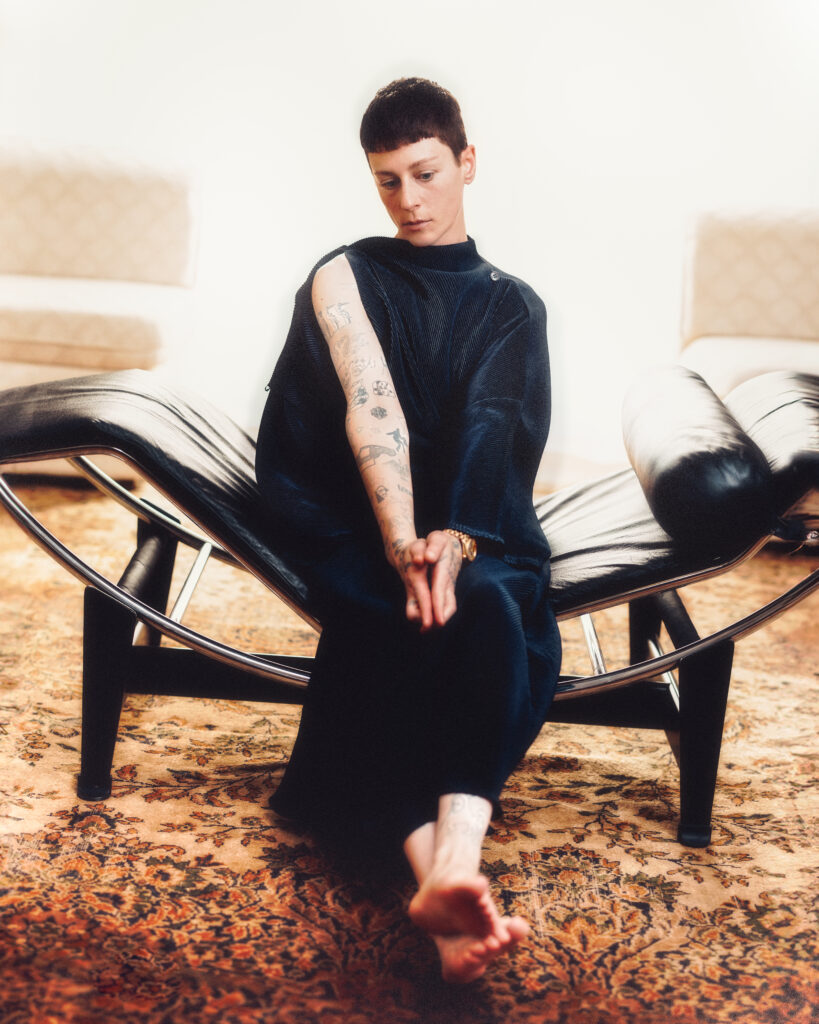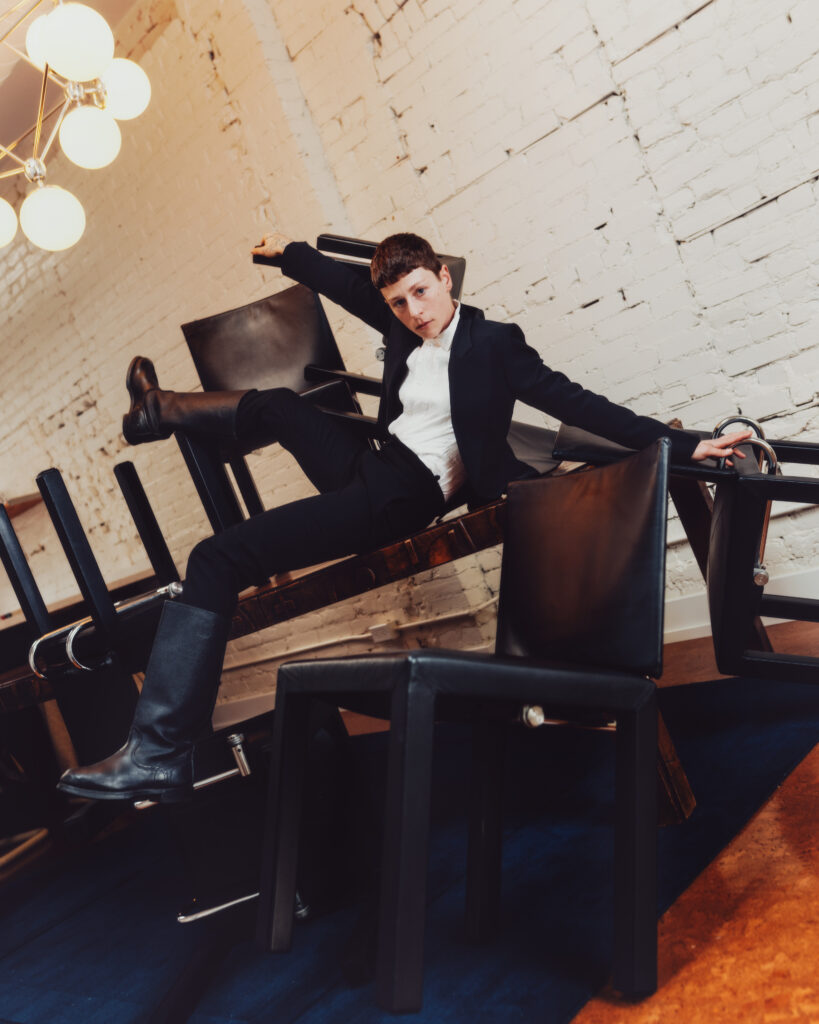In a compelling exchange between Toronto’s multifaceted creative, Sophie Blumenthal, and the insightful lens of photographer and filmmaker Miki Frances-Sankhāra, we’re granted a candid glimpse into Blumenthal’s dynamic journey through art and self-expression. Here, Blumenthal chats with Frances-Sankhāra, and reveals the relationship between creativity, personal style, and the pursuit of individuality in a world often confined by conventional expectations.
Miki Frances-Sankhāra: I phoned Sophie while she was out in LA. We were talking about her time at OCAD doing a BFA in sculpture, her previous work with the sculptor Isabelle Albuquerque, and the dreams of opening up another sister scrapyard in LA like the one she runs with her dad in Toronto.
“I mean, going to OCAD definitely, I think fuelled a fire that already existed in me. I’ve always known what I wanna wear—and since I was like a child who was like, you know, couldn’t leave the house, had no money… I was still just making anything work to achieve the aesthetic I wanted. I remember watching Grease, when I was probably four or five, and I was obsessed with Danny Zuko’s swagger. He wears this 70-long lapel dress shirt with that lapel suit. And I was though, ‘I don’t know how it’s going to happen, but I am going to somehow look like this.’ And I remember going to my parents’ office and cutting pieces of paper and taping them onto a crew neck t-shirt so that I could have the energy of that dress shirt.”

You were four years old when you started liking clothes and personally styling?
“Yep, honestly, probably exactly that. Growing up one of my mom’s daily life rituals was going to the tailor. She’d tailor everything. She’s very short, she’s even smaller than me. So she always had the sleeves taken up on her winter jackets and stuff like that. I remember I would just go sit and watch them do the chalk lines and she would stand up on a stage in front of a three-way mirror and I would just sit there. She was the person who paid attention to detail in my family.”
It still seems to be a thing for you. When we were shooting and [your wife] Kathleen came up the stairs with that jacket, you were immediately thinking about cropping and what you could do with it to make it yours.
“You know what, I ended up tailoring it.”

That’s great. I think there was embroidery or something going on, right?
“There was traditional trim that was hand-stitched, it just didn’t feel like it was right, I did a lot of research before I bought the jacket and they still use seal skin. There’s a lot of taboo around seals. I think there was the campaigns for clubbing baby seals, which is obviously inhumane and awful. I think most famously Morrissey in the ’80s said he refused to play a concert in Canada because of the fur industry. It feels very taboo, so I was very worried about that. And also just to be mindful of the imagery, textiles and patters I was wearing to make sure that I wasn’t appropriating. So I decided to make it a little more modern-looking.”
I feel that communicates bravery and not only being able to take a piece and say, ‘I’m gonna significantly alter this—even though some things on it are so special, they’re just not going to work with me in one way’. And it seems in that piece, what was in your mind was social impact, ecological consequences, cultural consequences, and thinking about how the piece will be read. Also in general it takes bravery to just like really cut and chop things.
“Yeah, for sure. Thank you.”
I’m so scared of touching my clothes. Like I don’t want to get rid of anything because I’m scared of ruining it or taking away from it something that was [intentionally] designed. Maybe I overthink it.
“I mean, but that again, speaks to the way you handle your garments. And if that’s what’s comfortable, that’s what’s comfortable. I wonder what looks or what aesthetics you’re keeping and enhancing in being mindful of that. Because the other thing too is like—I wish I was your size. I have always gravitated towards men’s clothing. I happen to be 5’3, and quite small. So it’s just never been an option to not tailor things.”
And that’s probably a back and forth you have with your clothing all the time. Trying to make it work for your body, but then also kind of wanting a different one and navigating dysphoria? It seems like style is the way you get around that.
“Oh, exactly. That’s a huge motivator in the way I build my wardrobe, and the way I dress myself is actually gender expression and gender identity, also through tailoring of garments in a way it hits, like making sure the shoulders look wide, but not too wide. And I never do anything darted or a-line ultimately. I end up feeling a bit like in drag, which is like so weird. But the more confident I get in my masculinity, I feel like the more excited I am to play around with women’s clothes too. I did a shoot for absolutely fabrics…”

Which was great by the way.
“Yeah, she’s unbelievable. She’s a stylist and has an unbelievable collection and opened up this shop. We visited her shop to dress Kathleen actually, because I sometimes dress Kathleen for events. And so I asked if I could bring Kathleen over to her studio to play in her wardrobe. And when we left, Kaelen reached out and asked if I would do a shoot for her. And only in the morning, I was very excited to do it, so I said yes. And only on the way over that morning, did it sort of dawn on me that the entire collection is women’s…”
Oh Right.
“So I was like, is she putting me in dresses? And I felt myself get meek and recoil, but it ended up being so liberating.”
Yeah, they’re great shots with that daytime disco energy. But then also it had a lot to do with the way you held yourself, I think, that’s what carried that feeling of handsome masculinity.
“She also did wheat paste. And so she did all these advertisements for the store and wheat paste around Toronto. And I was in a couple of them, so it’s such fun to see my face on the street.”
Sorry, it’s late to ask this but just so I get it right, I had been referring to you as she/her. Like, do you go by they/them?
“Thank you for asking. She, them, she works, he.. like, my wife calls me her husband sometimes. I feel like I’m more inclined to use firm pronouns when I’m around like straight people or like the closed-minded community I grew up in, just as like, you know..”
Right, yeah.
“But thank you for asking. Yeah, she/ her, they/them works for me.”
Okay, cool.
“Yeah, sometimes you can throw a hand in there. You can change it up. Yeah, yeah, all of them.”
I’ll be playful. Yeah, that’s sick, that’s fun.
“That’s like the first time I’ve ever answered that way. And I feel like honestly, fuck it. That is ultimately the truth, you know.”

I feel like we sometimes like going for the more firm binary route is about the audience we’re around… it comes with its own sense of safety. Not necessarily a great thing but it’s like ‘I don’t really have to explain myself right now.’
“Yeah, exactly.”
When did you feel your style started becoming you? We have Sophie at four years old carrying on this Danny Zuko vibe, and then learning more about tailoring and what works.. When did you feel like things started to feel right for you? Not to answer my question but to be honest, it sounds like you had that from the get-go.
“I feel like it started with me carrying on and seeking pieces. Like I was always very conscious of a piece in an outfit, not the entire thing. I want to feel like that and try to get as close as I can. It was like this feeling attached to a garment or like this sort of perception of how a person seems to feel in their clothes.”
“It started with that when I was like super duper young. In grade five I was like listening to Marilyn Manson in Black Sabbath and wearing bondage pants to keep her school when I was like prepubescent. That was stuff I just genuinely think is cool and feels like me and feels like part of the scene and community that I relate to. So I think I just went so hard and fast into what felt right and was where I belonged that I didn’t think much about what other people thought or what it meant for me to be like a young kid in Forest Hill— which is like a very wealthy neighbourhood where I grew up , and with a big Jewish community of which I am proudly a part of.”
“So much of that is this sense of safety. I think the community keeps tight to just like feel safe—and unfortunately, some of that creates this sort of social discomfort or this like safety in numbers… and that means if you’re an odd one out you’re gonna stand out. So I feel like I, when I was a preteen, I was just like, yeah, again, I had no choice. I was gonna be wearing what I was wearing. But I think when I was younger, I was less aware of how I would look to others. It was only until I got like bullied a few times. I remember I was wearing sort of more, I guess like pop-goth wear. It was like the ’90s rave look. (I was going to raves and stuff.) My teacher looked right at me, I think I put up my hand for the washroom and in front of everyone was just like, ‘No, you can’t, like you can’t go to the washroom’ in the middle of the lesson. I just like stared at her.. and she was like, ‘What are you gonna do? put a spell on me?’” I think it wasn’t until then that I was like, oh, do I look weird to other people?
“So that was like 12, 13, I’m smoking weed, I’m flirting with boys. I’m like not even aware of my sexuality yet. I was just dressing to feel comfortable in my body at that point because then you’re hitting puberty and you’re like, my chest isn’t big, but like your breasts are developing and you’re like, you know, you’re getting a little more curvaceous. I think that’s when I started sort of marrying feeling good in my skin and my body, and also learning enough about clothing to know what to buy and what kind of fit and how to tailor it to achieve an overall silhouette, which made me feel good in my clothes. But it also had to be pieces I was excited about and ultimately feel like me again. That’s like, ‘I don’t care what anyone says, this is cool as shit. This is me.’”
You’re actually like kind of the perfect person to have this conversation with, because I’m realizing more and more that the discourse that you have with your pieces form an intensely personal narrative, but like, you know, intersect with all of these larger abstractions that are still very much a part of who you are in the world… Do you have any recommendations for others on personal styling?
“They go, it comes down to two things. One, make sure you feel good in it, and it doesn’t matter if it’s blue jeans or a T-shirt, it means find the correct blue jeans and the correct T-shirt. Just make sure when you put it on, you’re like, yeah, that’s just right—and don’t let anyone influence that.
“And also, get resourceful. I don’t think there’s such a thing as the perfect garment. So you can alter things. Also, I don’t buy anything new…everything is from eBay, Grailed, Etsy, from reselling. I sell my clothes when I’m done with them or donate them and just use that toward a different purchase. Know where to look for things you like and expand your mind.”

